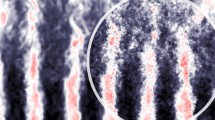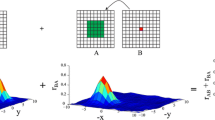Abstract
By using standard particle image velocimetry algorithms the interrogation windows are placed on a structured grid and the spatial resolution is manually chosen. Clearly, a better approach is to choose automatically the processing parameters and to adapt them locally both to the seeding density and flow conditions. An adaptive space resolution method is introduced herein and the performance assessment performed by using both synthetic and real images clearly shows the advantages of the technique.









Similar content being viewed by others
Abbreviations
- IDM:
-
Image deformation method
- MTF:
-
Modulation transfer function
- PIV:
-
Particle image velocimetry
- WW:
-
Weighting window
- a :
-
Modulation factor associated to the correlation step of the algorithm, dimensionless
- b :
-
Modulation factor associated to the weighted average step of the algorithm, dimensionless
- c :
-
Modulation factor associated to the dense predictor step of the algorithm, dimensionless
- k :
-
Iteration number, dimensionless
- m k :
-
Modulation factor at iteration k, dimensionless
- m ks,kf :
-
Combined modulation factor, dimensionless
- N :
-
Number of samples, dimensionless
- p :
-
Percentage of particles lost between the images, dimensionless
- r :
-
Maximum value of the correlation coefficient map, dimensionless
- r c :
-
Corrector displacement field, pixels
- r p :
-
Dense predictor displacement field, pixels
- r k :
-
Displacement field at iteration k, pixels
- \( \overline{{{\user2{r}}_{p}^{k - 1} }} \) :
-
Weighted average of the dense predictor displacement field, pixels
- u :
-
Horizontal displacement, pixels
- \( \bar{u} \) :
-
Mean, over the interrogation window, horizontal displacement, pixels
- v :
-
Vertical displacement, pixels
- W a :
-
Interrogation window linear dimension, pixels
- W b :
-
Linear dimension of the weighting window used in the weighted average step of the algorithm, pixels
- W bo :
-
Optimal linear dimension of the weighting window used in the weighted average step of the algorithm, pixels
- x :
-
Horizontal image coordinate, pixels
- y :
-
Vertical image coordinate, pixels
- δ :
-
Total error, pixels
- δ a :
-
Weighted average of the total error (all wavelengths), pixels
- δ l :
-
Weighted average of the total error (larger wavelengths), pixels
- ζ :
-
Adaptive parameter, \( r{\sqrt[4]{\sigma}} \)
- λ :
-
Spatial wavelength, pixels
- σ :
-
Standard deviation of the even local part, pixels
- Θ:
-
Standard deviation of the vorticity, dimensionless
- s :
-
Starting phase
- f :
-
Final phase
References
Astarita T (2006) Analysis of interpolation schemes for image deformation methods in PIV: effect of noise on the accuracy and spatial resolution. Exp Fluids 40:977–987
Astarita T (2007) Analysis of weighting windows for image deformation methods in PIV. Exp Fluids 43:859–872
Astarita T (2008) Analysis of velocity interpolation schemes for image deformation methods in PIV. Exp Fluids 45:257–266
Carlomagno GM, Nese FG, Cardone G, Astarita T (2004) Thermo-fluid-dynamics of a complex fluid flow. Infrared Phys Technol 46:31–39
Nogueira J, Lecuona A, Rodríguez PA (2005) Limits on the resolution of correlation PIV iterative methods. Fundamentals Exp Fluids 39:305–313
Rohàly J, Frigerio F, Hart DP (2002) Reverse hierarchical PIV processing. Meas Sci Technol 13:984–996
Scarano F (2002) Iterative image deformation methods in PIV. Meas Sci Technol 13:R1–R19
Scarano F (2003) Theory of non-isotropic spatial resolution in PIV. Exp Fluids 35:268–277
Schrijer FFJ, Scarano F (2008) Effect of predictor–corrector filtering on the stability and spatial resolution of iterative PIV interrogation. Exp Fluids 45:927–941
Susset A, Most JM, Honoré D (2006) A novel architecture for a super-resolution PIV algorithm developed for the improvement of the resolution of large velocity gradient measurements. Exp Fluids 40:70–79
Theunissen R, Scarano F, Riethmuller ML (2007) An adaptive sampling and windowing interrogation method in PIV. Meas Sci Technol 18:275–287
Utami T, Blackwelder RF, Ueno T (1991) A cross-correlation technique for velocity field extraction from particulate visualization. Exp Fluids 10:213–223
Willert CE, Gharib M (1991) Digital particle image velocimetry. Exp Fluids 10:181–193
Author information
Authors and Affiliations
Corresponding author
Rights and permissions
About this article
Cite this article
Astarita, T. Adaptive space resolution for PIV. Exp Fluids 46, 1115–1123 (2009). https://doi.org/10.1007/s00348-009-0618-5
Received:
Revised:
Accepted:
Published:
Issue Date:
DOI: https://doi.org/10.1007/s00348-009-0618-5




